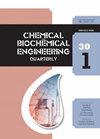Characterization of Sol-gel Derived Cobalt-doped Willemite via 2D Correlation Spectroscopy
IF 0.9
4区 生物学
Q4 BIOTECHNOLOGY & APPLIED MICROBIOLOGY
引用次数: 0
Abstract
Cobalt blue is one of the world’s most famous blue pigments, but it presents a threat to human health since it is toxic when inhaled or ingested. A safer and environmentally preferable way of obtaining cobalt blue-like pigments is doping of various nontoxic compounds with small amounts of cobalt. In this work, doping of zinc silicate (willemite, Zn 2 SiO 4 ) was carried out with 5, 10, and 15 mol% of Co with the aim of obtaining Zn 2– x Co x SiO 4 solid solution. Thermal properties of sol-gel derived samples were examined with simultaneous differential thermal and thermogravimetric analysis (DTA/TGA), which showed dehydration, decomposition, and burning effects, accompanied with mass loss and willemite crystallization effect at 800 °C. X-ray powder diffraction analysis (XRD) indicated the formation of willemite phase at 800 °C, accompanied with ZnO phase and increase in willemite crystallinity with annealing temperature rise from 800 to 1100 °C. Fourier transform infrared spectroscopy (FTIR) showed characteristic bands for present oxides and their bonds along with adsorbed water and carbon dioxide. Coloura-tion of prepared samples changed with annealing temperature, whereas higher Co concentrations and temperatures accentuated the intense blue colour. Diffuse reflectance spectroscopy (DRS) revealed an increase in absorbance with annealing temperature and specific bands as a result of different Co coordination present in the samples. The 2D correlation analysis of FTIR and UV-Vis spectra of the samples thermally treated at various temperatures was utilized to investigate and correlate the changes in the structure with the rise of the annealing temperature. The obtained correlation facilitated the finding of optimal process parameters for the desired pigment quality溶胶-凝胶衍生钴掺杂Willemite的二维相关光谱表征
本文章由计算机程序翻译,如有差异,请以英文原文为准。
求助全文
约1分钟内获得全文
求助全文
来源期刊
CiteScore
2.70
自引率
6.70%
发文量
23
审稿时长
>12 weeks
期刊介绍:
The journal provides an international forum for presentation of original papers, reviews and discussions on the latest developments in chemical and biochemical engineering. The scope of the journal is wide and no limitation except relevance to chemical and biochemical engineering is required.
The criteria for the acceptance of papers are originality, quality of work and clarity of style. All papers are subject to reviewing by at least two international experts (blind peer review).
The language of the journal is English. Final versions of the manuscripts are subject to metric (SI units and IUPAC recommendations) and English language reviewing.
Editor and Editorial board make the final decision about acceptance of a manuscript.
Page charges are excluded.

 求助内容:
求助内容: 应助结果提醒方式:
应助结果提醒方式:


